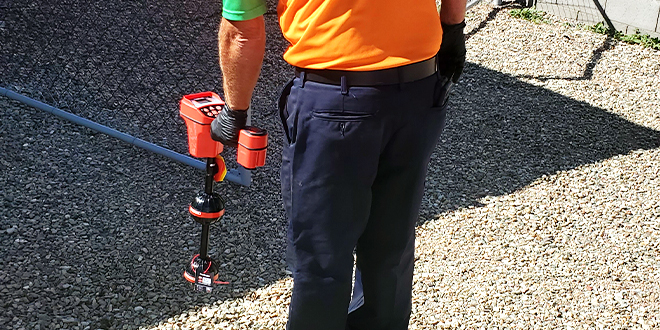The average household can lose up to 10,000 gallons of water a year through leaks as minor as worn toilet flappers or dripping faucets. The EPA estimates that 10% of homes in America waste at least 90 gallons of water a day. Make sure you’re not dealing with this kind of water loss by staying vigilant about leaks.
Learn more about slab leaks, how they happen, signs to watch out for, and how to detect and repair slab leaks in your home!

Signs You Have a Water Leak
It’s important to watch out for common signs of a water leak so you can identify the problem as early as possible. Left unchecked, a water leak can cause significant damage to your home.
Unexplained Changes to Your Water Bill
Your water bill tells you exactly how much water you’re using every month. The EPA indicates that a family of four should use no more than 12,000 gallons of water a month during the cold weather season. If you exceed this amount, you may have a sneaky leak such as a loose toilet flap or leaky valve. If your water bill has suddenly skyrocketed for no discernible reason, this is a prime indicator of a major water leak.
Suspicious Spots on the Lawn
Investigate any unusual puddles on your lawn. You shouldn’t find standing water anywhere in the yard unless you’re dealing with poor drainage and recent rains. Otherwise, this water is likely coming from under the ground where your pipes are in trouble. Leaky pipes can also cause lush patches of grass where it’s clear your lawn is getting more water from somewhere.
Mysterious Water Usage on Your Meter
If you suspect a leak, shut off all the taps and appliances that use water in your home and check the water meter. Wait an hour and check the meter again. If the numbers have changed while you weren’t using water in the home, you have a leak. Shut off water to your home to determine where the leak is located. If the water meter continues to run, the leak is outside the walls of the home. If the shutoff stops the meter from running, you have a leak somewhere in the house.
Unexplained Noises
Listen for suspicious sounds. If you hear dripping water, rattling pipes, persistent hissing, or the sounds of running water when you’re not using water in the house, you probably have a leak. Rattling sounds could also indicate other plumbing issues, such as poorly secured pipes, but this is still worth investigating with a professional.
Moisture and Discoloration
Puddles around appliances, at the base of walls, or beneath a drip in the ceiling are obvious signs of a leak. However, some moisture is less noticeable. If the walls or ceiling have dark spots, this could indicate that water is building up behind them. You might also start to see mold or mildew as these microbial growths begin to feed on the standing moisture in the area. Mold in particular can be very dangerous and destructive, so you should address it in the home immediately.
Damaged Ceilings or Walls
Persistent moisture can cause the ceiling to eventually droop. If you see pockets that are dipping downward, you should immediately investigate the problem before you’re left with a gushing hole. Walls may start to peel or blister if there’s a lot of water behind them. Any issues with your paint or wallpaper need attention.
Common Causes of Home Water Leaks
Identifying the culprit behind your home water leaks is the first step in remedying the problem. Once you’ve figured out what’s wrong, you can move forward to successfully repair the issue.
Rusty Pipes
Plumbing systems corrode with age. If your pipes are starting to rust, they’re quite literally wearing away and will eventually spring a leak. You should replace rusty pipes as soon as you notice the problem to keep your plumbing in prime condition and maintain clean water.
Broken Seals
Your appliances all have seals around the connectors where water enters. If these seals aren’t properly installed or maintained, they may begin to leak. Your dishwasher also has a seal around the door that’s meant to keep water in where it belongs.
Clogged Lines
A clog in your pipes can cause increased water pressure on the other side of the blockage. This will put an added strain on your pipes, which can cause them to spring a leak.
High Water Pressure
It’s nice to have good water pressure when you’re in the shower, but there’s a limit to what your pipes can handle. If the water pressure is too high, your faucets and pipes may start to leak. It’s important to know what your home is built to handle so you can set the water pressure accordingly. An experienced plumber can help.
Tree Roots
Tree roots can cause the ground around your water lines to shift. This in itself can lead to leaks. Tree roots can also work their way around and into your pipes depending on their age, composition, and condition.
What To Expect During a Leak Inspection
A plumbing inspection thoroughly evaluates all of the water lines, connections, and appliances in your home to make sure water is flowing where it should and not leaking where it shouldn’t. Professional plumbers may use acoustic detection, pressure gauges, flow meters, and other tools to identify and locate leaks. The plumber will also perform a thorough visual inspection around your home to make sure your pipes and seals are in good condition.
Expect a detailed report and expert recommendations for maintenance and repairs following your inspection. A plumbing inspection will help you increase the life of your entire plumbing system by identifying potential problems early. It can also help you save significantly in the long run by preventing and eliminating water loss through leaks.
Schedule a Leak Inspection Now
If you’ve experienced any of the above warning signs of a leak, contact Zest Plumbing and Drain to schedule an appointment with a skilled plumber today. Our team can thoroughly inspect your home to pinpoint any trouble areas and help you remedy leaks quickly and efficiently.




